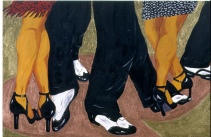
Educators have identified four stages of learning any physical skill: 1) unconscious incompetence; 2) conscious incompetence; 3) conscious competence; and 4) unconscious competence.
Edgar Degas said, "Only when he no longer knows what he is doing does the painter do good things." The same holds for tango. Only when the dancer reaches a stage of unconscious competence is the dancer touching the possibilities of inner Argentine tango. This is effortless mastery, the level of tango that is often described breathlessly.
Many years ago, Eckhart Haerter (an Argentine tango dancer and instructor from Germany) claimed that those performing tango typically only realize about 75 percent of their capabilities. One might associate such a performance with conscious competence that might typically result from fear pushing the dancers out of unconscious competence. An even weaker performance could result if the fear pushed one into conscious incompetence.
I would like to generalize with the idea that people actually learn Argentine tango in a spiral, progressing from the first stage of learning to the fourth over and over again. The unconscious competence at the previous level of skill becomes the unconscious incompetence at the next level of skill.
What does all this mean for teaching and learning Argentine tango and for developing an effortless mastery of Argentine tango?
Teaching typically involves lifting the student from unconscious incompetence to conscious incompetence. A few instructors also help their students make the transition from conscious incompetence to conscious competence. It nearly always remains up to the students to find their way to unconscious competence or effortless mastery.
The process of lifting the student from unconscious incompetence to conscious incompetence creates a tension between the student's current level of skill and the level of skill that the student realizes is possible. Sometimes students may get the feeling that their dancing is deteriorating because their awareness of dancing is expanding faster than their own physical skills. Most people find it nearly impossible to sustain conscious incompetence, however, and the typical process of learning is to work toward conscious competence by improving one's level of skill.
If the student is unable sustain the tension necessary to develop additional skill, the student is likely to slip backward into unconscious incompetence (which is the previous level of unconscious competence). Self-directed or supervised practice is often very important to creating new competencies, where the student first moves from conscious incompetence to conscious competence and then to unconscious competence.
Students typically quit formal learning when the instructor cannot create a new tension or the instructor creates a tension that is greater than the students want to or are able to sustain long enough to improve their skills. This can happen at any level of accomplishment—from that evident in first-time tango dancers to that evident in highly skilled dancers.
Teachers who emphasize memorized figures in their classes to the exclusion of other aspects of learning rarely create much tension in their students because what they teach does not threaten very greatly what the students have previously learned. Consequently, learning memorized figures may not offer very much to the highly motivated dancer. Furthermore, those teachers who emphasize memorized figures may not have to work very hard to get their students to move from conscious incompetence to conscious competence.
In contrast, those instructors who emphasize technique and the basic building blocks of tango are constantly pulling their students forward by revealing the next level of refinement. Students who wish to improve these skills must often be willing to accept considerable tension between their current skills and those revealed by the instructor. As such, those teachers who emphasize technique and basic building blocks may be called upon to work very hard to help guide their students from conscious incompetence to conscious competence (and sometimes these instructors get frustrated at their students' slow progress).
Effortless mastery comes when we reach unconscious competence—when we no longer think about what we are doing. Consequently, effortless mastery is frequently beyond instruction. Most instructors provide no guidance toward reaching effortless mastery. Some are destructive to the development of effortless mastery. The latter act like critics that constantly pull the person into conscious competence or incompetence, and in doing so destroy the state of mind in which unconscious dancing is possible. A few offer encouragement to their students to find unconscious competence, recognizing that in the end it is up to the individual dancers to find the unconscious competence that will give them effortless mastery.
How then, do we develop an effortless mastery of tango? We emphasize learning in our bodies rather than intellectually. We put aside the small voices of criticism, both external and internal—which often requires us to practice until we have developed confidence in our physical skills. We also put aside our judgements about what is good and bad dancing. We center ourselves and taste the delicious experience of the four connections in Argentine tango: the music, our partner, the floor, and the others on the dance floor. Those connections center us and guide us toward an effortless mastery.